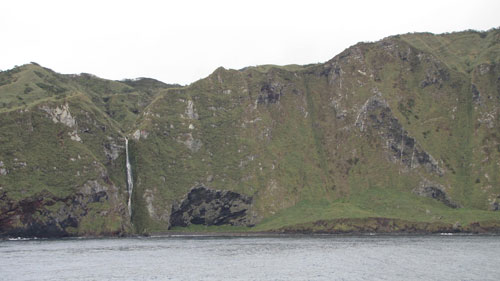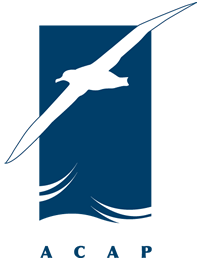
The steep slopes of Inaccessible Island, photograph by John Cooper
Peter Ryan (FitzPatrick Institute of African Ornithology, University of Cape Town, South Africa) has published in Ostrich Journal of African Ornithology on the petrel populations of rarely visited Inaccessible Island, part of the Tristan da Cunha group in the South Atlantic.
The paper’s abstract follows:
“Petrels that breed in burrows and return to their colonies after dark are among the mostj poorly studied seabirds. Brown Skuas Stercorarius antarcticus (family Stercorariidae) are major predators of burrowing petrels at many seabird breeding islands in the Southern Ocean, so monitoring the diet of skuas can provide insights into petrel population trends. Regurgitated pellets and other prey remains indicate that petrels comprise 94% (monthly range 91–97%) of all prey items in the pellets and other prey remains on Inaccessible Island, Tristan da Cunha. Other seabirds (0.7%), land birds (1.0%), subantarctic fur seals Arctocephalus tropicalis (0.5%) and marine animals (3.5%) make up the remainder of the Brown Skua diet. At least 12 species of petrels are eaten, including two species that are not known to breed on Inaccessible Island, but five taxa comprised over 98% of all petrels eaten: Fregetta storm petrels (44%), White-faced Storm Petrels Pelagodroma marina (23%), Broad-billed Prions Pachyptila vittata (21%), Great Shearwaters Ardenna gravis (6%) and Common Diving Petrels Pelecanoides urinatrix (5%). Pellets containing 2 or 3 avian prey items (15% of pellets) were more likely to contain conspecifics than heterospecifics, indicating either local differences in prey distribution or individual dietary specialisation. The prey composition changed seasonally linked to the phenology of the prey species, with White-faced Storm Petrels more common in the skua diet in spring, and Fregetta storm petrels in summer. Fur seals and Great Shearwaters have become more important in the skua diet, reflecting known or suspected increases in the populations of these species on the island, whereas the populations of Common Diving Petrels and Subantarctic Shearwaters Puffinus elegans may have decreased. Modal tarsal length of Fregetta storm petrels changed from 37 mm in 1987/89 to 39 mm in 2009, suggesting a possible increase of F. tropica relative to F. grallaria in the skua diet. However, overall there has been little change in the diet of Brown Skuas on this island over the last four decades.”
Reference:
Ryan, P.G. 2024. Long-term changes in petrel populations on Inaccessible Island, Tristan da Cunha, inferred from the diet of Brown Skuas Stercorarius antarcticus. Ostrich Journal of African Ornithology 95: 163-171.
John Cooper, Emeritus Information Officer, Agreement on the Conservation of Albatrosses and Petrels, 07 October 2025

 Français
Français  English
English  Español
Español